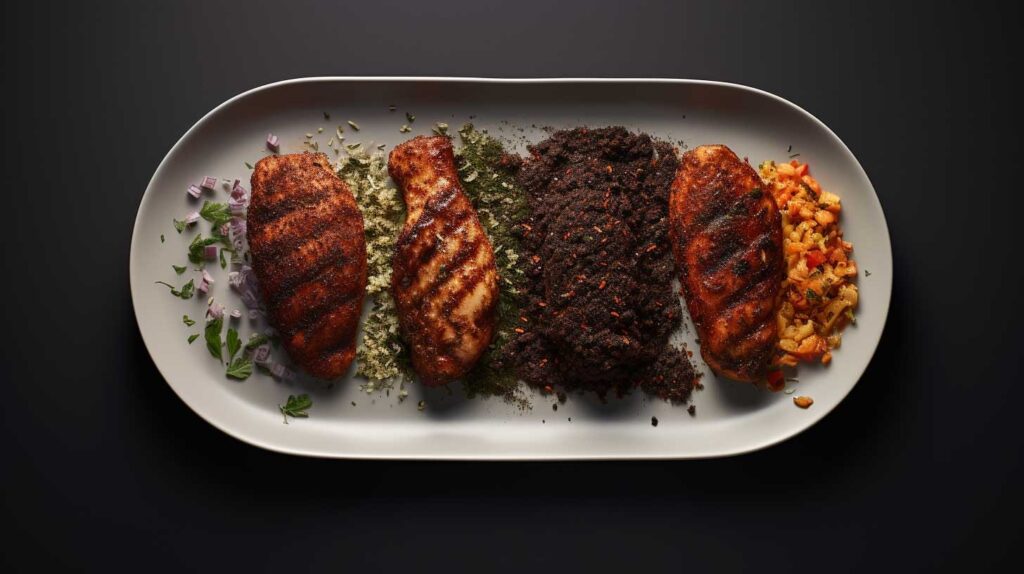The allure of jerk seasoning lies in its intricate blend of spices and its ability to transform the simplest ingredients into a feast for the senses. Whether you’re a seasoned cook or a curious food lover, the journey from traditionally jerked chicken and pork to the more delicate flavors of fish can seem daunting, each with its own set of nuances and techniques to master. The quest for that perfect balance of fiery heat and aromatic sweetness is one many embark on, but not all can grasp without guidance.
With years of experience and a passion for the art of Caribbean cuisine, we delve into the smoky depths of jerk cooking. Here, the secrets of marinating meats, the interplay of spices, and the art of achieving the signature char are demystified, tailored for those who yearn to recreate these flavors authentically at home.
As you continue reading, you’ll find a trove of insights and tips to elevate your culinary skills, ensuring that the rich tradition of jerk cooking is not only preserved but also thrives on your plate.
Key Takeaways
- Jerk cooking technique involves marinating meat or fish with a blend of spices and seasonings, grilling slowly over a hardwood charcoal fire, and infusing flavors for a unique and aromatic dish.
- The key ingredients in jerk cooking include jerk marinade for authentic taste, hardwood charcoal for smokiness and depth of flavor, Scotch Bonnet Peppers for signature heat, and brown sugar for balancing heat and enhancing caramelization.
- Traditional jerk chicken preparation involves a wet marinade with various spices and seasonings, marinating the chicken for hours or overnight, grilling over hardwood charcoal in a steel drum jerk pan, and serving with lime, barbecue sauce, or traditional Caribbean sides.
- Pork jerk is slow-cooked over pimento wood for smokiness, has a spicy kick from Scotch bonnet peppers and jerk spice, uses a marinade with black pepper, soy sauce, thyme, and garlic, and is grilled over charcoal for rich flavors.
Jerk Cooking Technique Overview
In jerk cooking, we marinate the meat or fish with a blend of spices and seasonings before grilling it slowly over a hardwood charcoal fire. This slow cooking process allows the flavors to infuse into the meat, creating a unique and aromatic dish. The marinade, often referred to as jerk marinade, is the key to achieving the authentic taste of jerk chicken, pork, or fish.
Typically, the marinade includes the iconic Jamaican jerk spice, which is a combination of allspice, Scotch bonnet peppers, cloves, cinnamon, and thyme. This spice rub not only imparts a rich and smoky flavor but also brings a kick of heat that sets jerk cooking apart.
The technique of grilling over hardwood charcoal adds depth to the flavor profile, resulting in a tantalizing blend of smokiness and spice. This method of cooking is a celebration of freedom, as it allows for a relaxed and communal atmosphere where friends and family gather around the fire, savoring the slow-cooked, succulent jerk chicken, pork, or fish.
The process embodies the spirit of liberation and enjoyment, making jerk cooking not just a culinary experience, but a cultural celebration of flavors and togetherness.

Key Ingredients for Jerk Seasoning
Let’s delve into the essential elements that constitute the foundation of authentic jerk seasoning, essential for infusing the distinct flavors of jerk chicken, pork, or fish. When creating the perfect Jamaican jerk sauce, these key ingredients are crucial:
- Scotch Bonnet Peppers: These fiery peppers are a staple in Jamaican cuisine and are essential for providing the signature heat in jerk seasoning.
- Brown Sugar: The sweetness of brown sugar balances the heat from the peppers and enhances the caramelization of the meat during the cooking process.
- Pimento Wood: Pimento wood is integral to the traditional Jamaican jerk cooking technique. The wood chips from the pimento tree are used to add a unique smokiness to the meat during grilling.
These elements, combined with a spice mixture including allspice, cloves, cinnamon, and other fragrant spices, create the authentic and vibrant flavors of Caribbean cuisine.
Understanding the significance of these components allows for the creation of a jerk seasoning that captures the essence of Jamaican culinary traditions.
Traditional Jerk Chicken Preparation
Continuing from our exploration of key ingredients for jerk seasoning, we delve into the traditional method of preparing jerk chicken, a staple of Caribbean cuisine.
The authentic Jamaican Jerk experience is all about the flavors of the Caribbean and the unique cooking process. To achieve this, we start with the wet marinade, which is crucial for infusing the chicken with the iconic Jamaican jerk spice. This wet marinade is a blend of fresh thyme, scallions, garlic cloves, peppers, allspice berries, soy sauce, olive oil, lime juice, brown sugar, salt, and pepper.
The chicken is then generously coated with this flavorful marinade and left to soak up the rich spices for a few hours or preferably overnight. Once marinated, the chicken is grilled over hardwood charcoal in a traditional steel drum jerk pan. The slow cooking process over low heat allows the chicken to absorb the smoky flavors while remaining tender and juicy.
Whether served with lime, barbecue sauce, or traditional Caribbean sides such as rice and beans, this traditional jerk chicken preparation truly captures the essence of Jamaican food.

Pork Jerk: A Unique Flavor Profile
We can’t talk about pork jerk without mentioning its smoky and spicy flavors, which come from the slow cooking process over pimento wood.
Understanding the cultural and culinary history behind pork jerk adds depth to our appreciation of its unique flavor profile.
It’s fascinating to see how the technique has evolved over time, from using pit fires to modern grilling methods.
Smoky and Spicy Flavors
As we delve into the unique flavor profile of pork jerk, it’s essential to understand the combination of smoky and spicy elements that define its distinctive taste. The smokiness of pork jerk is achieved through slow cooking over hardwood charcoal or in a steel drum jerk pan, while the spicy kick comes from the use of Scotch bonnet peppers and Jamaican jerk spice.
To create this flavorful blend, ingredients like black pepper, soy sauce, fresh thyme, and garlic cloves are combined in a food processor. The pork is then marinated in this mixture before being grilled over a charcoal grill, infusing it with the rich smoky and spicy flavors.
This process results in a mouthwatering dish that captures the essence of freedom and boldness in taste.
Now, let’s explore the cultural and culinary history behind the evolution of pork jerk.
Cultural and Culinary History
Exploring the roots of pork jerk unveils a rich tapestry of culinary traditions and cultural influences.
In the Jamaican countryside, the tradition of pork jerk originated from the indigenous Taíno people and was later influenced by the cooking techniques of enslaved Africans and Maroons. Originally used for preserving meat, pork jerk was traditionally cooked by slow-cooking the meat over pimento wood, imparting a distinctive smoky and spicy flavor.
The main ingredients of Jamaican jerk spice, such as allspice and Scotch bonnet peppers, contribute to the unique flavor profile.
This cultural and culinary history has evolved from the preservation technique of jerked or dried meat to a renowned cooking method, with jerk seasonings now being used on a variety of ingredients beyond pork, such as chicken, fish, shrimp, and vegetables.
Exploring Fish Jerk Variations
Upon experiencing the growing popularity of fish jerk variations, our team delved into exploring the diverse flavors and techniques used in preparing this unique dish. Fish jerk variations offer a tantalizing medley of smoky and spicy flavors that perfectly complement the natural taste of fish.
To achieve this delectable dish, we discovered the following key techniques and ingredients:
- Medium-High Heat: Grilling fish jerk variations over medium-high heat ensures a perfect balance of smokiness and tenderness.
- Allspice Berries: These berries are a crucial component of the jerk seasoning, adding depth and complexity to the flavor profile.
- Wood Chips: Infusing the fish with the aromatic essence of wood chips enhances the smokiness, elevating the overall taste experience.
In addition to these techniques, a dry rub featuring jerk seasoning, combined with the zesty tang of lime juice and zest, provides a burst of flavors that harmonize with the fish.
As we continue to explore fish jerk variations, we’re constantly amazed by the endless possibilities and the freedom to experiment with different ingredients and cooking methods.

Regional Variations in Jerk Spice Blends
We have observed diverse regional variations in jerk spice blends, reflecting the unique culinary traditions and preferences of different geographical areas. For instance, Jamaican jerk spice typically includes a blend of whole allspice, Scotch bonnet peppers, and other aromatic ingredients.
In New York, however, some variations might include additional spices like cloves, cinnamon, and nutmeg. When preparing jerk meats with these regional spice blends, we highly recommend marinating the meats in the jerk seasoning, preferably overnight, to allow the flavors to fully infuse.
After marinating, the meat can be wrapped in plastic wrap and refrigerated until ready to cook. Additionally, serving jerk meats alongside traditional accompaniments like fried dumplings, at room temperature, can complement the bold flavors of the dish.
These regional variations in jerk spice blends offer a diverse and exciting range of flavors, allowing for an exploration of different taste profiles. In the next section, we’ll delve into serving and pairing jerk meats to enhance the overall dining experience.
Serving and Pairing Jerk Meats
When serving and pairing jerk meats, it’s important to consider complementary flavors and accompaniments that enhance the overall dining experience.
Jamaican jerk spice, with its bold and spicy flavor, pairs well with a variety of sides and beverages. Here are some tips for serving and pairing jerk meats:
- Traditional Caribbean Sides: Consider serving jerk meats with traditional Caribbean sides such as rice and beans, plantains, or coleslaw to complement the bold flavors of the jerk seasoning.
- Citrus Accents: Squeeze lime over the jerk meats to add a burst of citrus that balances out the spiciness and enhances the overall flavor profile.
- Beverage Pairings: Jerk meats can be paired with a variety of beverages, including a refreshing glass of milk to help cool down the heat, or a fruity tropical drink to complement the Caribbean flavors.








